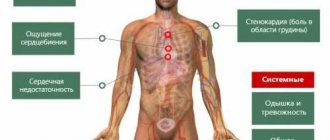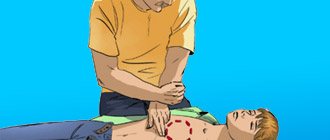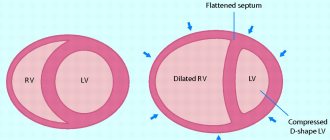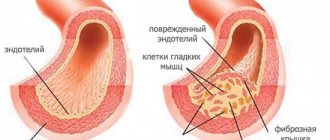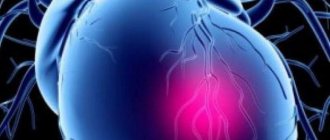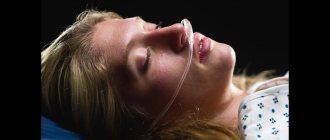During physical activity, psycho-emotional stress, or excessive consumption of coffee or strong tea, tachycardia occurs - an increase in heart rate (over 90 beats per minute). After the cessation of exposure to the adverse factor, heart function is restored. But not in the case when tachycardia is of pathological origin. The pulse may increase in case of deadly diseases. Therefore, treatment of tachycardia at home is carried out under medical supervision.
Symptoms of an attack of tachycardia
Typically, attacks of tachycardia are accompanied by the following symptoms:
- Heartbeat;
- Weakness;
- Dyspnea;
- Feeling short of air;
- Dizziness (to the point of fainting);
- Loss of consciousness.
The main sign that all patients pay attention to is heartbeat. Normally, we do not feel the contraction of the heart. It does its job without us noticing. And with the development of an attack of tachycardia, this work becomes obvious.
The person begins to feel every blow. People describe this feeling differently: “my heart fluttered like a bird,” “it pounded in my chest,” “I felt it begin to pulsate.”
Very often this feeling is combined with the appearance of weakness. I immediately want to sit down and relax, my muscles become like cotton wool. It is almost impossible to continue doing any work.
It becomes difficult to breathe. It is difficult for a person to breathe, it seems as if there is not enough air. Breathing becomes frequent and shallow.
In difficult situations, the head begins to spin, “spots flash” before the eyes. A person may even lose consciousness and faint.
Diagnostics
Paroxysmal SVT is characterized by complaints of repeated attacks of palpitations that suddenly begin and end, often accompanied by weakness, dizziness, and sometimes presyncope and syncope.
In young children, paroxysmal tachycardia is manifested by episodes of sudden weakness, lethargy or anxiety, refusal to feed, and with prolonged manifestations, manifestations of heart failure increase.
Chronic SVT is characterized by an asymptomatic course, up to the development of arrhythmogenic myocardial dysfunction (dilation of the heart chambers with a decrease in contractility).
Examination plan:
- ECG in 12 leads;
- 24-hour ECG monitoring (CMECG);
- test with dosed visual load;
- transesophageal EPI (electrophysiological study).
Endocardial EPI in children is rarely performed for diagnostic purposes, usually only as a stage of RFA (radiofrequency ablation).
Additionally, research is carried out:
- EchoCG to exclude structural heart diseases;
- clinical blood and urine analysis;
- blood electrolytes;
- thyroid hormone levels (according to indications).
If a connection between SVT and current myocarditis is suspected, a complex of biochemical, immunological, bacteriological and virological studies is carried out to confirm or exclude it.
Causes of rapid heartbeat
Such symptoms can occur for various reasons. The most harmless of them are physiological. Each of us has experienced an attack of tachycardia after intense physical activity or severe emotional shock.
In such situations, our body actively produces adrenaline, which makes the heart beat faster. There is no need to be afraid of them: this is normal, this is how it should be. As a rule, such attacks are short-lived, they pass literally within a few minutes after rest.
Of course, everything here is very individual, from the degree of stress that can provoke an attack to the recovery time.
Similar attacks can be caused by drinking strong tea or coffee, as well as “energy drinks” that are fashionable among young people. In these cases, there is no reason for concern, however, this is an alarming “bell” indicating that the body is finding it difficult to cope with the influence of these drinks, and it is better to limit their quantity.
In addition, attacks of tachycardia can occur against the background of other pathological conditions:
- With high fever;
- When blood glucose levels decrease;
- With hyperfunction of the thyroid gland;
- For “acute” abdominal diseases;
- For anemia, etc.
However, the symptoms of the underlying disease will be dominant. For example, if a person has a high temperature, he will first complain of chills or a feeling of heat, sweating, headache, weakness, and most likely will completely forget about the heartbeat.
And only if you specifically ask him, will he think and answer: “Yes, probably there is something like that.” In such situations, tachycardia as a separate symptom is not paid attention to, but the disease-cause is treated mainly. As soon as the person gets better, the feeling of the heartbeat disappears by itself.
Attacks of tachycardia are a real problem when their cause lies in the heart itself. They arise without visible provoking factors, occur longer and more severely, and require more attention.
Such attacks indicate the presence of one or another heart pathology. These may be disorders of the conduction system, when the generation and propagation of the stimulating impulse changes, the presence of foci of necrosis of the heart muscle, heart defects, myocarditis.
For what indicators and symptoms should a person be helped?
Normal heart rate in an adult should vary from 50 to 75 beats per minute and coincide with the number of contractions of the heart muscle. Tension, filling and rhythm of the pulse are also important. The main symptoms of paroxysmal ventricular tachycardia, heralding the onset of an attack, are:
- the occurrence of pain and a characteristic push in the chest;
- difficulty breathing;
- increased blood pressure;
- shortness of breath and lightheadedness;
- upset stomach, trembling hands;
- darkening of the eyes;
- increase in size and swelling of the neck veins.
Symptoms of other types of tachycardia, the appearance of which the patient may need emergency medical care, include increased sweating, severe pain and a feeling of heaviness localized in the left side. An attack of sinus tachycardia is most often preceded by high fatigue in combination with a pulse rate of more than 90 beats per minute. An exacerbation of the atrial variety is accompanied by panic attacks, severe fear and pulsation in the range of 160-250 beats. An attack of ventricular paroxysmal tachycardia usually begins with tinnitus, a sharp decrease in blood pressure, flatulence, nausea and pulsation of 150-200 beats per minute.
The patient must be supported if his pulse rate exceeds the threshold of 125-130 beats per minute. In children and adolescents, tachycardia requiring medical intervention may be accompanied by pale skin, dizziness and complaints of pain in the chest area. In infants, an impending attack is diagnosed by an increased breathing rate, groundless whims and severe restlessness.
How to relieve an attack at home
When an attack of tachycardia occurs, first of all, we must answer the question for ourselves: will we relieve it at home or seek medical help? If even the slightest doubt arises when answering it, it is better to call a doctor.
Yes, of course, this may be a trifle, and the alarm was raised in vain. But what if not? It's better to play it safe once again. So, the first rule: if we are not 100% sure that the attack is safe and we can easily stop it on our own, we must seek help from specialists.
At home, we can relieve only those attacks whose cause is known to us and is not related to heart pathology.
For example, it is absolutely not necessary to bother a doctor if a healthy man develops palpitations and shortness of breath after working out in the gym, or a girl develops these symptoms against the background of hysteria. In such cases, you can easily cope with the attack at home.
The main task in such a situation is to eliminate the cause that caused the attack of tachycardia.
- First of all, you should immediately stop physical activity;
- The person can be seated or laid down;
- He needs to be provided with access to fresh air;
- You should free your neck from constricting clothes or a tie;
- You can give him a glass of water to drink.
These simple steps will eliminate tachycardia in the shortest possible time.
In fact, the secret here is extremely simple: such attacks, in principle, do not need to be stopped. They go away on their own. We can only speed up this process somewhat by stopping the person in time and helping him to calm down. And then his body will do everything itself.
Cardiac tachycardia - what is it?
Before you figure out how to help a patient with tachycardia, you need to know exactly what kind of illness it is and what symptoms indicate it.
Cardiac tachycardia is an arrhythmia accompanied by an increased number of heart contractions that exceed the normal number of 90 per minute. Proper breathing will help urgently in this situation, but more on that later.
We have already explained: cardiac tachycardia - what it is, now you need to find out exactly what types of disease occur, what symptoms indicate it, in order to immediately help the patient cope with the symptoms and prevent serious consequences.
First aid
If we decide that we cannot cope on our own, then the first thing we should do is immediately call an ambulance.
Rule number two: if we decide to call an ambulance, then we must do it immediately, and only then begin to provide first aid ourselves.
Our capabilities in case of a real serious attack of angina pectoris are extremely small; often only a doctor can provide real help.
That's why we don't waste time: minutes count! We should begin providing first aid only after we are sure that we have done everything possible to ensure that the doctor appears as soon as possible.
Further, first aid for tachycardia may include the following:
- Lay the patient down with the head end elevated. This way we increase blood supply to the heart and at the same time make breathing easier. In case of loss of consciousness, it is better to turn the victim's head to the side. Otherwise, there is a risk that he will choke on his tongue or vomit if he suddenly starts vomiting.
- Provide maximum air access. Doctors often use oxygen masks in such cases. But we don’t have them, so we have to do what we can: open the window and unbutton the person’s collar or loosen the tie so that nothing is tight around the neck.
- Apply Corvalol, Valocordin or valerian tincture. We should not give a person any “serious” heart medications, even if we really want to help. The fact is that we cannot understand what kind of arrhythmia he has; for this we need an ECG. Therefore, we can easily make mistakes with medications and only make things worse. Let's limit ourselves to the usual sedatives. Of course, the effect from them will be minimal, you need to understand this. But this is the best we can do.
- Carry out a reflex effect on the vagus nerve. The vagus nerve has an inhibitory effect on the functioning of our heart. Therefore, in order to remove its excessive activity, you can try to stimulate this nerve. Here are some simple ways:
- Massage of the carotid sinuses (they are located at the angle of the lower jaw at the level of the upper edge of the thyroid cartilage) - starting from the left, for 10-15 seconds;
- Pressing on the eyeballs - with the eyes closed, with little force, otherwise you can damage the eye;
- Straining while holding your breath at maximum inhalation for 30-40 seconds.
Let's make a reservation right away: none of them is a panacea. They can be effective only for supraventricular tachycardia, and not in all cases.
Therefore, if you are afraid to do something like this or are not sure that you can do everything correctly, then it is better not to: there may be more harm than good. No one will say “thank you” to you because, in a fit of desire to help, you gouged out a person’s eye. You can try, but only very carefully.
Antiarrhythmic drugs that stop an attack of tachycardia
All existing modern antiarrhythmic drugs can be divided into four classes:
- Cardiac sodium channel blockers (typical representatives are procainamide, lidocaine, propafenone);
- Beta-blockers (propranolol, atenolol, metoprolol, etc.);
- Cardiac potassium channel blockers (amiodarone, sotalol);
- Cardiac calcium channel blockers (verapamil, diltiazem).
Each group has its own mechanism of action and its own indications for use.
Let us consider in more detail those drugs that are used in emergency cases to stop an attack of tachycardia.
- Amiodarone (also known as cordarone) is a very strong drug that is used for severe arrhythmias. Suitable for stopping almost any arrhythmias. Copes well with attacks of atrial fibrillation or flutter. It is also used for ventricular fibrillation. It is highly effective.
- Lidocaine. It is used exclusively for ventricular arrhythmias, since due to its mechanism of action it is useless in other cases. However, it does its job perfectly. It is a cheap and accessible drug. For arrhythmias, it is prescribed only intravenously.
- Verapamil. This drug, on the contrary, helps well specifically with supraventricular arrhythmias. In addition, it is used for angina and hypertension.
- Beta blockers. During an attack of tachycardia, short-acting (propranolol) or ultra-short-acting (esmolol) drugs are used. They reduce the heart rate well, but at the same time they act exclusively symptomatically and have virtually no effect on the source of the arrhythmia. Much more often, beta blockers are prescribed to chronic patients to prevent such attacks, but their use in an emergency situation is also possible.
- Procainamide. Like amiodarone, it is suitable for any type of tachycardia. It is somewhat weaker, therefore, as a rule, treatment begins with it, and in case of ineffectiveness, they then switch to amiodarone. Not suitable for severe organic heart pathology, for example, if there has been a myocardial infarction in the past. In such cases, amiodarone is immediately prescribed.
Many of these drugs come in tablets. Therefore, there is a great temptation to take them yourself before the doctor arrives. You can, for example, just in case, purchase one of them in advance at the pharmacy and keep it at home just in case. This is not the best idea.
Firstly, there is no universal drug suitable for any type of tachycardia. The same amiodarone has a number of serious contraindications, the presence of which in humans you and I may not be aware of.
Secondly, during an attack of tachycardia, drugs act quickly enough only when administered intravenously. Tablets in such situations are usually not effective enough. They can do more harm than good. Only a doctor should determine the medicine, its dose and route of administration for arrhythmia.
The situation is somewhat different with chronic patients, in whom such attacks occur periodically. Such people have already been examined, they have been given a definite diagnosis, and treatment has been prescribed.
In some cases, doctors recommend certain medications to stop attacks. Then another thing: you can and should use them before the ambulance arrives. But here we are no longer talking about self-medication, but about following medical recommendations.
Traditional medicine
If we cannot use medications as first aid, then the question arises: why not try traditional medicine recipes? Everything there is natural, which means it’s safe. In addition, the Internet offers us a lot of similar recipes.
Let us give as an example some of the most harmless of them:
- Rosehip infusion: two tablespoons of dried berries are poured with a glass of boiling water, cooled to room temperature and allowed to brew.
- Chamomile tea: Brew chamomile flowers in a teapot for 15-20 minutes.
- Mint tincture with alcohol: add 10-15 drops to a glass of water.
- Valerian infusion: collect the root of the plant and prepare it at the rate of 15 g per 150 ml of cold water, let it brew for 24 hours.
Unfortunately (or fortunately) they are all ineffective. If a person is having a serious attack, chamomile and rose hips certainly will not help him, and the advice on using mint or valerian tincture is essentially the same as taking a drop of Corvalol: we will get a slight sedative effect, nothing more.
In general, it can be used, but you shouldn’t expect any miracle. Again, the situation is urgent: we simply won’t have time to brew chamomile tea.
However, traditional healers offer us more serious methods, for example, tincture of clover flowers. At the same time, some even indicate that this is such a strong remedy that you need to discuss the dose with your doctor.
In fact, no normal doctor in his right mind would prescribe such a prescription instead of a regular medicine. Why? Yes, simply because the effectiveness of traditional medicine is much inferior to real medicines.
All the best properties of plants that we know have been used in modern preparations for a long time, the rest is just a dummy. You can argue a lot about “chemistry” and naturalness, but this debate is about nothing. You need to use only what really helps, otherwise it will get worse.
Modern drugs undergo serious quality control, including on safety issues. Replacing them with traditional medicine recipes is unwise and dangerous.
Features of relieving an attack
In adults
In adults, attacks of tachycardia are often caused by external causes, such as stress or physical activity. If we clearly grasp such a connection, then there is nothing to worry about: we simply calm the person down and let him rest.
If an attack occurs at rest, suddenly, you need to immediately sound the alarm and call an ambulance. This may be the first time a rhythm disorder has arisen, and it is very dangerous.
It is especially unpleasant when such attacks occur in young, apparently healthy men: unfortunately, in such situations, sudden cardiac death may develop.
If we understand that the attack is serious, then we do not try to relieve it ourselves, but immediately call an ambulance.
We can only provide minimal first aid, and then emergency care is provided by doctors using ECG and special medications.
In pregnant women
The main feature of pregnant women: they are regularly examined. As a rule, if they have hidden heart problems, the attending physician will find out about this and give appropriate recommendations.
In such situations, an attack of tachycardia is not an unpleasant surprise: the woman is informed in advance that this can happen and what first aid should be provided to her.
If a woman is healthy, and according to the results of a heart examination, everything is fine, then most likely her attack of tachycardia is caused by excessive emotional or physical stress. Again, you need to try to calm down and relax. If this does not help and the condition worsens, you should immediately call an ambulance.
It should be remembered that pregnant women should absolutely not take a number of medications, as they can have a negative effect on the fetus. Therefore, the general recommendation that we do not give victims any medications on their own without a doctor’s prescription becomes even more relevant here.
In older citizens
In the elderly, attacks of tachycardia are usually associated with heart disease. Therefore, if this is not the first time this happens, then we strictly perform the actions that the doctor previously recommended to us.
And then, if the condition has returned to normal, the next day we seek medical help as planned. If it was not possible to relieve the attack on your own, then we call an ambulance.
If tachycardia suddenly appears for the first time, then it is better not to delay calling an ambulance. The situation can be extremely serious.
Help for children
Fortunately, tachycardia in children, as a rule, is physiological. The attacks occur in response to stress and quickly go away on their own. Children simply don’t notice many of them.
Their appearance is especially typical in adolescence, when the body undergoes restructuring, and the appearance of short-term rhythm disturbances is normal.
In general, assistance to children during an attack of tachycardia is no different from that of adults. The dosage of drugs will be less, but this is the concern of the pediatrician. Parents should not self-medicate their child.
The main advice when tachycardia appears in a child: do not panic ahead of time. Serious heart disease in childhood is rare. However, just in case, it is better to get examined in the future - it will be calmer.
Paroxysmal tachycardia in children: treatment, emergency care
»» № 5″98
TO HELP THE PRACTITIONER Olishevko S.V., Bykova E.K., Mishurovsky E.E., Maslyak L.I., Shevchenko N.M.
Emergency Department of Medical Unit No. 170, Korolev
Among all cases of paroxysmal supraventricular tachycardia (SVT), approximately 90% are reciprocal atrioventricular tachycardia (RAVT). Reciprocal means due to the reentry mechanism. There are two options for RAVT: 1.
Reciprocal AV - nodal tachycardia, in which the circulation of the impulse (“re-entry”) occurs within the AV node, and 2. RAVT with the participation of an additional conduction path, in which anterograde conduction occurs through the AV node, and retrograde conduction occurs through an additional path.
Much less frequently, in no more than 10% of cases in clinical practice, paroxysmal atrial tachycardia occurs, in which the source is in the atrial myocardium.
There are no well-controlled clinical studies, and animal studies indicate a risk to the fetus. fetal damage.
Possible if the drug is administered during pregnancy, but the potential benefits may outweigh the potential risks.
Human research or information obtained during research or because of demonstrated risk to embryonic development. However, the potential benefits of using the drug may outweigh the potential risks.
For example, the indication may be acceptable in life-threatening situations or for serious medical conditions where drugs cannot be administered safely or are ineffective.
Animal or human studies or reports during research or subsequent marketing of the drug have shown definite evidence or risk of fetal abnormality, clearly outweighing any benefit to the patient.
Table 1: Pharmacological treatment in the context of pregnancy.
The main way to diagnose paroxysmal tachycardia is to record an ECG. If the QRS complexes are not changed / not widened during tachycardia / - supraventricular tachycardia (Fig. 1). If the QRS complexes are widened during tachycardia, the tachycardia can be either supraventricular (with blockade of the branches of the His bundle) or ventricular (Fig. H).
Signs of ventricular tachycardia (VT) in these cases are the presence of AV dissociation and/or conducted (or “drain”) complexes. If AV dissociation and conducted or draining complexes are not noticeable on the ECG, the term “tachycardia with widened ventricular complexes” is used (it is impossible to accurately determine the localization of the source of tachycardia).
To clarify the expected localization of the source of tachycardia with widened complexes, additional criteria have been developed based on assessing the width and shape of the QRS complexes, however, in emergency situations, if the localization of the source of the arrhythmia is not clear, tachycardia should be considered ventricular.
Additional signs are not used when providing emergency care.
Beta blockers have been widely used during pregnancy in the treatment of hypertension, hypertrophic cardiomyopathy, thyrotoxicosis, mitral stenosis fetal tachycardia and are generally well tolerated.
However, beta blockers cross the placental barrier and are associated with a number of adverse effects, such as intrauterine growth restriction, respiratory depression, neonatal bradycardia, and hypoglycemia, especially when treatment is initiated early in pregnancy.
In pregnancies complicated by hypertension and treated with propranolol, no congenital anomalies were observed, but decreased fetal growth was reported.
Rice. 1. Paroxysmal supraventricular tachycardia. Relief with intravenous ATP. A - ECG during sinus rhythm; B - ECG during paroxysm of NVT (p 1 - retrograde P waves).
Severe depression of the ST segment in leads V 3 -V 6; B - Relief of NVT after intravenous administration of ATP (frequent ventricular extrasystoles and the appearance of signs of premature excitation of the ventricles are noted - limited by arrows).
Administration of atenolol no later than the first quarter is associated with fetal growth retardation. A meta-analysis in patients with hypertension that analyzed the risk of beta blockers during pregnancy found an increase in the number of babies who are “small for gestational age.” The concentration in breast milk is approximately five times higher than in plasma.
Some data on verapamil and diltiazem. Clinical studies report no maternal teratogenicity and no adverse effects during pregnancy.
However, maternal hypotension, fetal heart block, and decreased contractility have also been reported during treatment of fetal arrhythmias. There is also a risk for decreased blood flow to the uterus.
For these reasons, verapamil should be avoided in acute treatment, especially if adenosine is used. The effects of diltiazem are less known, but similar limitations are suggested.
Treatment of paroxysmal tachycardias
In cases of severe hemodynamic disturbances accompanied by clinical symptoms: a sharp drop in blood pressure, cardiac asthma and pulmonary edema, loss of consciousness, emergency electrical cardioversion is necessary.
For paroxysmal SVT, as a rule, a discharge with a power of 26-50 J (2-2.5 kV) is sufficient, for VT - about 75 J. For pain relief, intravenous administration of Relanium is used. In more stable conditions, the basis of treatment is the use of antiarrhythmic drugs.
The interval between drug administration is determined by the clinical situation and the response to previous treatment measures.
When to call an ambulance for tachycardia
Summarizing the above, let us once again repeat those situations when an ambulance should be called immediately:
- The attack occurred for no apparent reason, at rest.
- The attack does not stop, and the person’s condition worsens.
- An attack in a patient with chronic heart disease cannot be stopped with conventional medications.
In such cases, calling an ambulance is the main action to provide assistance. Self-medicating in such situations can be life-threatening.
Only a doctor knows how to relieve an attack of tachycardia caused by serious reasons.
